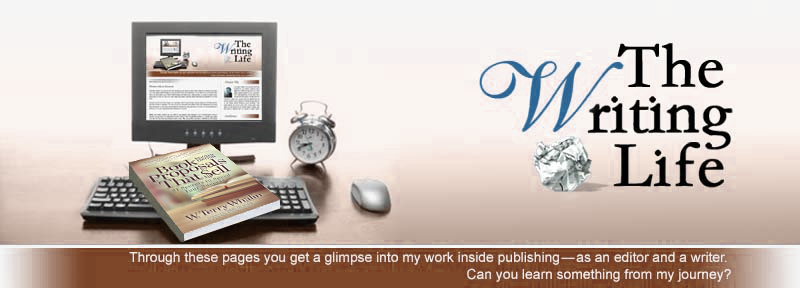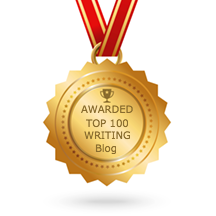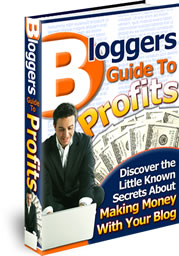Write, Publish and Sell Your Book
Last week I read Patricia Fry's book, The Right Way To Write, Publish And Sell Your Book, This book is packed with a realistic picture of book publishing. I wanted you to see my review: "As an author, a former book acquisitions editor and a literary agent, I want to know the straight scoop about the book publishing industry. It's often hard to find realistic information because even people in the business don't want to mess with the dreams and aspirations of writers and give them the straight scoop."

"Patricia Fry in The Right Way To Write, Publish And Sell Your Book helps every writer understand the business aspect of books. I love what she wrote on page 15 at the end of the first chapter, "Too many authors fail solely because they give up. Authorship is not designed to be a hobby. It isn't something that you can successfully manage as an afterthought. It demands your full attention. Your future in writing and publishing is almost completely up to you. If you do the necessary research and work--if you exercise persistence, perseverance and patience while maintaining realistic expectations--you will experience success."
"Whether you are looking for insight about writing a query or a book proposal or wondering about print on demand and self-publishing or looking for some innovative ideas to market your books to specialty shops or libraries or even how to keep a record of your expenditures or manuscript submissions, Fry has packed a lot into these pages. No matter your level of publishing experience you can profit from a careful reading and even re-reading of this book."
Besides this review, I wanted to give you a taste of the contents in The Right Way To Write, Publish And Sell Your Book. Patricia sent me this article with permission to use it.
The Post-Publication Book Proposal By Patricia Fry
Did you go ahead and produce your book without writing a book proposal? Maybe you simply didn't know what a book proposal was or you didn't understand its value. And now you regret your decision. I have good news. It may not be too late to benefit from writing a book proposal for your fiction or nonfiction book.
Yes, I'm suggesting the post-publication book proposal--a document designed to help you:
* More appropriately identify your target audience. * Discover how to reach this audience. * Create a more realistic promotions plan. * Identify your book's hooks. * Continue to build on your platform. * Re-evaluate the focus and slant of your book. * Find new ways to build promotion into your book.
The post-publication book proposal is especially useful for authors of ebooks or those who have used POD technology, because they can easily make necessary changes. But, even if you have boxes and boxes of unsold books stored in your garage, you will benefit from writing an after-publication proposal.
Re-evaluate Your Book
Start by writing a one or two sentence description of your book. Is this the same portrayal you envisioned when you first wrote the book? Or has your original purpose or intent changed?
Tip: Use customer feedback to help you define your book.
Once you have succinctly determined the purpose, scope and focus of your book, you can more easily identify the appropriate target audience.
Who is Your True Target Audience?
You may have written your healthy eating book for the fast-food restaurant crowd, but have since discovered that healthy eaters are purchasing it.
It could be that book reviewers and sales statistics show that your female fantasy adventure appeals more to the juvenile and young adult market than adult chick lit fans.
There's no law against changing your proposed target audience. In fact, it is important that you re-evaluate your audience from time to time. Determine who is purchasing your book. Reexamine the story or text with a critical eye to more accurately pinpoint your ideal audience--those people who will gain something from or enjoy reading your book.
If you have written a book that is not well-received by the very audience you hoped to reach, either shift your promotional efforts to another audience or consider a revision. A major mistake many authors make is to write a book for an audience who really doesn't care.
Where Are Your Readers?
Identifying your audience is just part of the path to successful authorship. Now you must locate them so you can reach them through your promotional efforts. Maybe you've discovered that the largest audience for your guidebook to vacation retreats isn't the singles crowd, but businessmen and women. Where will you find these readers? Presumably, at business conferences, self-help workshops, civic organization meetings and travel sites. What sites do they visit, which magazines do they read? Promote accordingly.
Be careful about saying that your book is for every reader. A couple of years ago in St. Louis, I had a private consultation with an author who had attended my book promotion workshop. He said that his book wasn't selling and he wanted some promotional ideas. He told me that his book was for a general audience and it featured proof that there is no God. This--a mainstream book? I don't think so. I hope that I convinced this author that his audience probably consisted of people like him--scientists with the same theory, agnostics, atheists and some philosophers. I suggested that he would find his potential readers at the same Web sites he frequents, reading the same magazines and attending the same lectures. Can you see how a shift in his perceived target audience could make a positive difference in this author's bottom line?
Identify Your Book's Hooks
A hook is a concept or a theme that helps to attract your target audience--something that captures their attention. Perhaps you were only slightly successful in a quest to attract readers for your romance novel. After writing a post-publication proposal, you may realize that you have some hooks in there that you hadn't considered. For example, the fact that your story is set in New Hampshire during the Civil War adds two additional hooks. Perhaps you can promote this book to U.S. history and Civil War buffs. You'll probably discover eager readers all over the state of New Hampshire. If the story isn't too racy, it might be welcomed into public school curriculum. And you thought that women were your only audience.
Additional hooks for a nonfiction book featuring garden designs might be office garden designs, container gardening for apartment dwellers, regional gardening, etc. Do you see how you could promote to each of these demographics?
Continue to Build on Your Platform
It's never too late to build a platform. Ideally, you have your platform well-established before you publish your book. For your book on the new women-on-motorcycles trend, presumably, you are a lady biker. You've taken all of the instructional and safety courses--maybe you even teach them. And you have contributed several articles to Women Riders Now Magazine, Biker Ally Magazine and Women on Wheels. But there's more that you can do.
Establish weekend rides for women, start an organization, build a Web site, circulate a newsletter and sign books at bike shops, for example. Continue to build a reputation in your field through exposure.
Establish New Promotional Tactics
Your after-publication book proposal might reveal that you've been just skimming the surface of your promotional potential with your book. Maybe you've been promoting online, you're on amazon.com, you have had a few reviews in the obvious places and you've done a couple of talks locally. Consider what more you can do. Write for appropriate magazines, solicit more reviews in publications related to the theme or genre of your book, approach the library market with your book, start blogging and do talk radio shows, for example.
If yours is a novel, get your name out there by submitting stories to magazines. Find print and digital publications that use fiction in Writer's Market (Writer's Digest Books), The Best of the Magazine Markets for Writers (Writer's Institute Publications), by doing a Google search using keywords, “fiction markets,” “literary magazines,” etc. And don't forget to consider those magazines that you like to read.
Snoop on Your Competition
What else is out there like your book? How are the other books selling? For those books listed in Ingram's database, you can check sales by calling, 615-213-6803 (have the ISBN handy). Also find out how other authors in your genre/topic are promoting their books. Glean this information by visiting author Web sites. Check out their blogs, personal appearance pages and contests or other activities they've launched on behalf of their books. Subscribe to their newsletter. You might even contact these authors to discuss promotional tactics such as piggyback marketing.
Make Changes in All the Right Places
For those of you who are struggling with book sales and who face a decision regarding a revision, and for authors with POD and ebooks, here are some ideas for building promotion into your next printing: For nonfiction:
* Hire an editor. * Add an index. * Update facts, figures and resources. * Create a workbook either as part of the original book or to accompany it. * Add value by including more examples, tips, techniques, forms and/or anecdotes. * Consider fictionalizing your memoir or true story if you are virtually unknown. . * Include more people in your book. Interview old-timers for your local history, profile early pioneers, note your information sources, etc. * Soften the message. Avoid trying to change minds, hearts and habits.
For Fiction:
* Hire an editor. * Include more selling hooks--give a character diabetes, twins, a horse or amnesia, for example. * Include effective grab hooks--teasers and surprises in the storyline that make people want to keep reading. * Make your book more attractive. Washed out, muddy, uninteresting covers do not attract attention.
Competition for authors is at an all time high. According to Bowker, over 291,000 books were produced in 2006. And the instance of failure has also reached new levels. In 2004, there were approximately 1.2 million titles in print, and a whopping seventy-six percent of them sold fewer than 100 copies that year. (BISG) The Jenkins Group says that over seventy percent of all titles fail to make a profit.
Authors who treat the process of publishing like a business and consider their book a product, have an advantage. While professionals preach and cajole hopeful authors to write a book proposal as a first step on their publishing journey, many of you don't. The good news is that it may not be too late. If your book sales could use a boost, consider writing a post-publication book proposal. This could just mean the difference between a failed book and a successful one
Patricia has recently completed a 27-page ebook featuring the post-publication book proposal. Order your copy of The Author's Repair Kit at http://www.matilijapress.com/.
For more information on writing a pre-publication book proposal, read The Right Way to Write, Publish and Sell Your Book or How to Write a Successful Book Proposal in 8 Days or Less by Patricia Fry.
Patricia Fry is a full-time freelance writer, speaker, literary consultant and the author of 28 books. She is also the president of SPAWN (Small Publishers, Artists and Writers Network). Patricia's hallmark book is, The Right Way to Write, Publish and Sell Your Book (revised second edition). Also you can follow Patricia's informative blog.
----------------------------
I hope from this sample article you can see the value with Patricia's materials and insight. Just this single article is packed with insight and worth several readings. This type of publishing insight can make a real difference in your writing life.
Labels: book, book publishing, Patricia Fry





















3 Comment:
Hi Terry:
Patricia's book is great! If you're interested, you might want to check out a book marketing workbook (it's a free, downloadable pdf) that I put together for my company, Wheatmark, Inc. We hope it's useful to authors who are trying to identify and reach their core target markets. Any feedback is most appreciated! here's a direct link to it: http://www.wheatmark.com/assets/bookmarketecture.pdf
All the best,
Kat Meyer
Hello Kat,
I glanced at your resource and it looks thoughtful and well-done. I'm delighted to know about it and look forward to reading it in detail soon.
I noticed Wheatmark is one of the publishers that Mark Levine discusses in his book, The Fine-Print Of Self-Publishing. If you don't know about this book, you might want to get it because you are ranked, "Just OK" and it might give you some ideas for change and improvement from a third party. No pressure from me but just a thought.
Again thank you for calling to my attention (and my readers) about this resource.
Terry
Author of Book Proposals That Sell
Thanks, Terry. I'll let the publishing services department know about that -- I know they keep track of our rankings according to various sources, and they'll find that useful if they don't already know. A lot of the time our ranking is not super high because we cost more than the big guys. We're highly-personalized and spend much more time than most of the less expensive services making sure that our authors are happy. So - we are working on getting our message out there that we may cost more but we are worth it :).
We're also putting as much into developing new and effective services for marketing (both pre-publication - making sure that marketability is built into the book as much as possible) and post publication. So, I'll keep you posted when we have any news on that end that might be useful to your readers.
Thanks for the blog -- it's a great read!
All the best,
Kat
Post a Comment
That's the writing life...
Back to the home page...